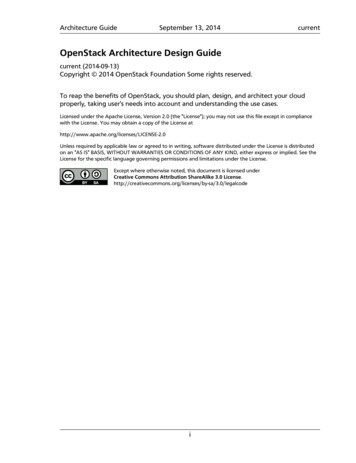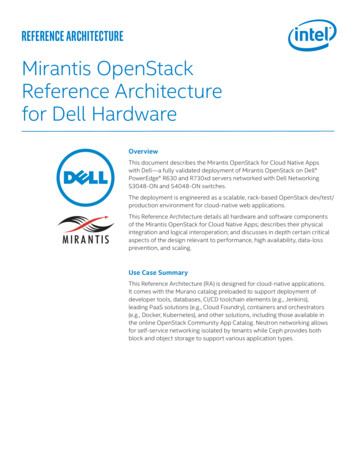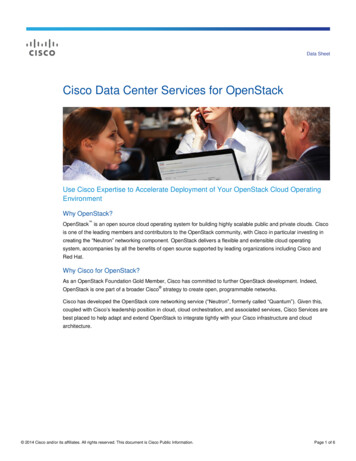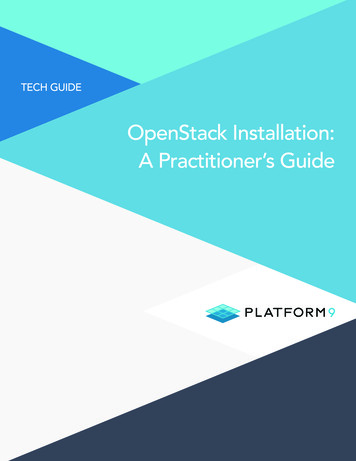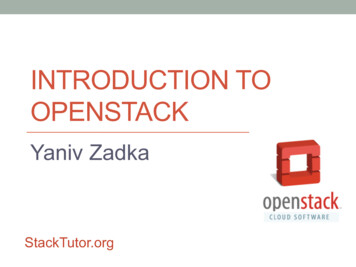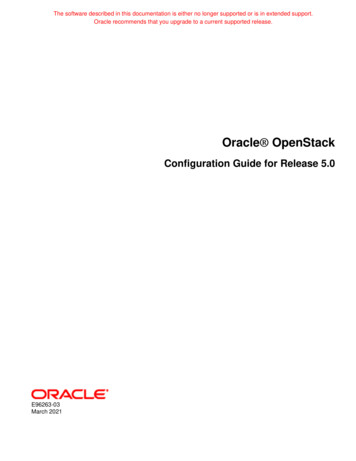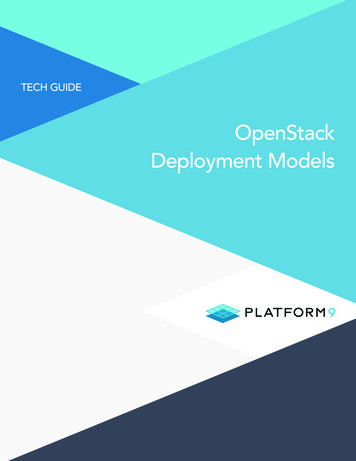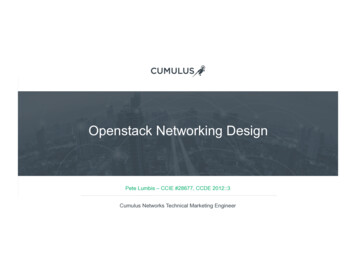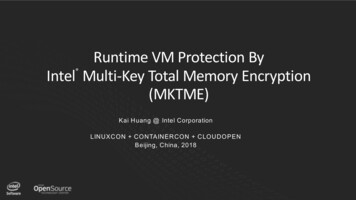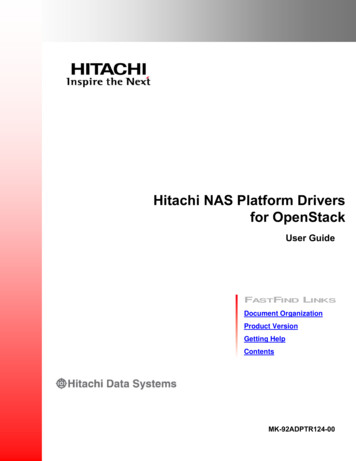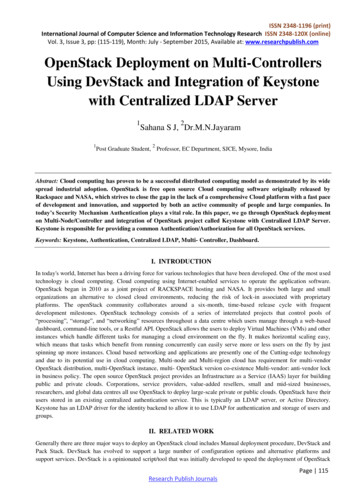
Transcription
ISSN 2348-1196 (print)International Journal of Computer Science and Information Technology Research ISSN 2348-120X (online)Vol. 3, Issue 3, pp: (115-119), Month: July - September 2015, Available at: www.researchpublish.comOpenStack Deployment on Multi-ControllersUsing DevStack and Integration of Keystonewith Centralized LDAP Server12Sahana S J, Dr.M.N.Jayaram12Post Graduate Student, Professor, EC Department, SJCE, Mysore, IndiaAbstract: Cloud computing has proven to be a successful distributed computing model as demonstrated by its widespread industrial adoption. OpenStack is free open source Cloud computing software originally released byRackspace and NASA, which strives to close the gap in the lack of a comprehensive Cloud platform with a fast paceof development and innovation, and supported by both an active community of people and large companies. Intoday’s Security Mechanism Authentication plays a vital role. In this paper, we go through OpenStack deploymenton Multi-Node/Controller and integration of OpenStack project called Keystone with Centralized LDAP Server.Keystone is responsible for providing a common Authentication/Authorization for all OpenStack services.Keywords: Keystone, Authentication, Centralized LDAP, Multi- Controller, Dashboard.I. INTRODUCTIONIn today's world, Internet has been a driving force for various technologies that have been developed. One of the most usedtechnology is cloud computing. Cloud computing using Internet-enabled services to operate the application software.OpenStack began in 2010 as a joint project of RACKSPACE hosting and NASA. It provides both large and smallorganizations an alternative to closed cloud environments, reducing the risk of lock-in associated with proprietaryplatforms. The openStack community collaborates around a six-month, time-based release cycle with frequentdevelopment milestones. OpenStack technology consists of a series of interrelated projects that control pools of“processing”, “storage”, and “networking” resources throughout a data centre which users manage through a web-baseddashboard, command-line tools, or a Restful API. OpenStack allows the users to deploy Virtual Machines (VMs) and otherinstances which handle different tasks for managing a cloud environment on the fly. It makes horizontal scaling easy,which means that tasks which benefit from running concurrently can easily serve more or less users on the fly by justspinning up more instances. Cloud based networking and applications are presently one of the Cutting-edge technologyand due to its potential use in cloud computing. Multi-node and Multi-region cloud has requirement for multi-vendorOpenStack distribution, multi-OpenStack instance, multi- OpenStack version co-existence Multi-vendor: anti-vendor lockin business policy. The open source OpenStack project provides an Infrastructure as a Service (IAAS) layer for buildingpublic and private clouds. Corporations, service providers, value-added resellers, small and mid-sized businesses,researchers, and global data centres all use OpenStack to deploy large-scale private or public clouds. OpenStack have theirusers stored in an existing centralized authentication service. This is typically an LDAP server, or Active Directory.Keystone has an LDAP driver for the identity backend to allow it to use LDAP for authentication and storage of users andgroups.II. RELATED WORKGenerally there are three major ways to deploy an OpenStack cloud includes Manual deployment procedure, DevStack andPack Stack. DevStack has evolved to support a large number of configuration options and alternative platforms andsupport services. DevStack is a opinionated script/tool that was initially developed to speed the deployment of OpenStackPage 115Research Publish Journals
ISSN 2348-1196 (print)International Journal of Computer Science and Information Technology Research ISSN 2348-120X (online)Vol. 3, Issue 3, pp: (115-119), Month: July - September 2015, Available at: www.researchpublish.comfor development purposes, hence “Dev” Stack. The Multi-node installation setup runs different OpenStack services ondifferent nodes. A basic installation requires the three nodes they are Controller-node, Network-node and Compute-node.1) Controller Node: It runs control services, such as message queue, database and API services for the Identity Service(Keystone).2) Network Node: It runs networking services and is responsible for virtual networking needed for people to createprivate or public networks, and uplink their virtual machines into external networks.3) Compute Node: It run the virtual machine instances in OpenStack.Authentication plays a vital role in today’s world. Every multiuser service needs some mechanism to manage who canaccess the application and which actions each person can perform. A private cloud is no exception and OpenStack hasstreamlined these functions into a separate project called Keystone. Authentication plugins are used and implementedshould be generic enough to cover completely customized authentication solutions in cloud environment with theOpenStack Identity Service (Keystone). In OpenStack cloud services, authentication is a process which positively verifiesthe user identity by validating a set of credentials supplied by the user. These credentials are initially a user name andpassword or a user name and API key, and authentication token will be issued to the user in response to these credentials.Many enterprise applications use LDAP as the foundation for user authentication. The LDAP- Lightweight DirectoryAccess Protocol is a client/server protocol for accessing and managing directory information specifically X.500-baseddirectory services. Keystone is the only one in OpenStack to responsible for creation of users, their roles, and to assignwhich project(s) they belong to. OpenStack have their users stored in an existing centralized LDAP server, or ActiveDirectory (which offers LDAP capabilities). The main challenging part here is to achieve integration of Keystone with anexisting identity store such as an LDAP server.Fig.1: OpenStack deployed on Multi-Controllers with Centralized LDAP TopologyKeystone has an LDAP driver for the identity backend to allow it to use LDAP for authentication and storage of users andgroups. Integrating an identity back end with Centralized LDAP, by enabling the LDAP identity driver in the “keystone.conf” file by replacing “driver sql” with “driver ldap”.III.USER IDENTITY VALIDATION VIA KESTONE WITH OPENSTACK DASHBOARDHorizon is a OpenStack’s web-based self-service portal and it sits on-top of all of the other OpenStack components viaAPI interaction. The Fig.2 depicts the OpenStack cloud is deployed on a Node/Controller using DevStack. WhenDevStack “./stack.sh” script runs successfully, it will be provided with the specific IP address, username and password thatcan be used to access the Horizon (dashboard). According to our project OpenStack DevStack is successfully deployed onMulti-Nodes/Controllers and the OpenStack server is in “UP” state.Page 116Research Publish Journals
ISSN 2348-1196 (print)International Journal of Computer Science and Information Technology Research ISSN 2348-120X (online)Vol. 3, Issue 3, pp: (115-119), Month: July - September 2015, Available at: www.researchpublish.comFig.2: DevStack-OpenStack deploymentThe Fig.3 depicts the dashboard (horizon) it is accessed through the provided OpenStack Server IP and login credentials.Fig.3: OpenStack Login Screena) Creating new user on LDAP server through keystone via CLI or GUI:There are some commands to follow up to create new user, tenant and roles in OpenStack. Once the new OpenStack useris created and stored in database, we can check the newly created Openstack User by issuing the “keystone user-list”command on CLI. The Fig.4 depicts newly created OpenStack user with name “onecloud”.Fig.4: Created new OpenStack UserTo verify that the existing domain entry is present in LDAP Server with ldapsearch operation through CLI by using“ldapsearch -x -b 'dc openstack,dc org' '(sn onecloud)'” command on CLI. The Fig.5 depicts domain entry stored inLDAP Server.Fig.5: Newly created OpenStack User(onecloud) successfully stored in LDAP ServerPage 117Research Publish Journals
ISSN 2348-1196 (print)International Journal of Computer Science and Information Technology Research ISSN 2348-120X (online)Vol. 3, Issue 3, pp: (115-119), Month: July - September 2015, Available at: www.researchpublish.comb) Validate Keystone against Centralized LDAP/AD:To validate OpenStack user against Centralized LDAP through Horizon by login with newly created User nameonecloud) and Password. The Fig.6 depicts OpenStack login screen with newly created username and password.Fig.6: OpenStack Login Screen with new username and passwordThrough GUI/Dashboard, In Identity section, check users tab to see the newly added user in the database. The Fig.7depicts Keystone user list through Dashboard.Fig.7: Keystone users listIV. ADVANTAGES OF CENTRALIZED LDAP IN CLOUDi.Centralized LDAP supports high availability and redundancyii.Centralized password security policies in one authorityiii. Centralized identity and passwords across both UNIX and Windowsiv. Simplified creation and deletion of usersV.LIMITATIONS OF CENTRALIZED LDAPSince Centralized LDAP Server act as global service and serving large amount of user management data to “N” numberof OpenStack servers(Controllers) on different regions. Most high availability systems will fail in the event of single ormultiple independent (non-consequential) failures. A crucial aspect of high availability is the elimination of single pointsof failure (SPOFs). In this case, most systems will protect data over maintaining availability.Page 118Research Publish Journals
ISSN 2348-1196 (print)International Journal of Computer Science and Information Technology Research ISSN 2348-120X (online)Vol. 3, Issue 3, pp: (115-119), Month: July - September 2015, Available at: www.researchpublish.comVI. SOLUTION TO OVERCOME OF LIMITATIONSLoad balancing is a staple solution in virtually every data center. A load balancer is a device that acts as a reverse proxyand distributes network or application traffic across a number of servers. Load balancing aims to optimize resource use,maximize throughput, minimize response time, and avoid overload of any single resource. Using multiple componentswith load balancing instead of a single component may increase reliability and availability through redundancy.Failover support: When a major failure occurs in the Centralized LDAP Directory Server specified by the primary URLand the server no longer responds to network requests, LDAP clients attempts to connect to the secondary LDAPDirectory Server specified by the secondary URL. The Fig.8 depicts virtual load balancing in cloud environment.Fig.8: Virtual Load BalancingVII. CONCLUSIONVirtualization can exist without the cloud, but cloud computing cannot exist without virtualization. LDAP is rapidlybecoming a defacto standard for remote authentication and authorization of users. Centralized LDAP is a solution toaccess centrally stored information over network. This centrally stored information is organized in a directory that followsX.500 standard. The main advantage of this approach is that the information can be grouped into containers and clients canaccess these containers whenever needed. In this paper, Centralized LDAP approach enables to achieve High availabilityand redundancy.REFERENCES[1] “Engineering Enterprise Applications To Ensure The Highest Level Of Availability And Fault Tolerance In TheCloud”, by brian jimerson, published june 2012.[2] Stratus Technologies, “Server Virtualization and Cloud Computing: Four Hidden Impacts on Uptime andAvailability,” A White Paper by Stratus Technologies, June 2013.[3] Oracle, “Architectural Strategies for Cloud Computing,” An Oracle White Paper in Enterprise Architecture, August2009.[4] Juniper Networks, “Implementation Identity Federation in a Hybrid Cloud Computing Environment Solution Guide,”October 2009.[5] “A User Identity Management Protocol for Cloud Computing Paradigm”, by Lawrence Kehinde ,Vol.4 No.3, March2011.[6] Cloud Standards Customer Council, “Security for Cloud Computing 10 Steps to Ensure Success”, June 2012.[7] Energy Efficiency for Data Center and Cloud Computing: A Literature Review, Volume 3, Issue 4, October 2013.[8] Private Virtual Infrastructure: A Model for Trustworthy Utility Cloud Computing UMBC Computer ScienceTechnical Report Number TR-CS-10-04.[9] The Security Division of EMC, “The Role of Security in Trustworthy Cloud Computing”, RSA white paper, April2009.Page 119Research Publish Journals
OpenStack distribution, multi-OpenStack instance, multi- OpenStack version co-existence Multi-vendor: anti-vendor lock in business policy. The open source OpenStack project provides an Infrastructure as a Service (IAAS) layer for building public and private clouds. Corporations, service providers, value-added resellers, small and mid-sized .
